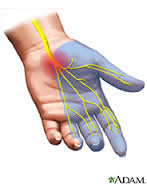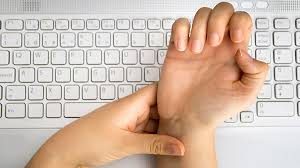Carpal Tunnel Syndrome
Wrist Pain: Carpal Tunnel Syndrome
Do you have wrist pain? Are you feeling numbness in your fingers and hand? Is it painful to race your motorbike or type on your phone?
There are many causes of wrist pain. Carpal tunnel syndrome (CTS) is the most common tunnel syndrome in the body. The median nerve is compressed under the flexor retinaculum at the wrist joint.
Not only you
This syndrome is common and has received a lot of attention because studies have shown its link to occupation-related injury. Repetitive, forceful or vibrative actions of hand or fingers such as typing on a computer, doing assembly work, food processing works, or heavy lifting are few examples of high-risk work.
Median nerve may be compressed because of;
• Trauma (e.g. Colles fracture, lunate dislocation)
• Ganglion
• Wrist swelling, flexor para tendonitis
• Arthritis (OA, RA)
• Diabetes Mellitus
• Acromegaly
• Hypothyroidism
• Collagen disease
• Use of corticosteroids and estrogen
• Smoking
• Pregnancy (20% of pregnant women). Due to fluid retention, there will be swelling in carpal tunnel resulting in the compression of the median nerve.
How is this tunnel look like?
The carpal tunnel is formed by the scaphoid, lunate and triquetrum bones which form an arch and flexor retinaculum or transverse carpal ligament on top or on the palmar side of the wrist. Tendons of Flexor digitorum profundus, flexor digitorum superficialis and flexor pollicis longus muscles and median nerve pass through this tunnel. So, any increase in the volume of structures within the tunnel can cause the compression of the median nerve. For example, even a slight swelling of the synovial sheath of flexor tendon may force median nerve up against the firm, inelastic transverse carpal ligament.
What people with carpal tunnel syndrome complain of?

Symptoms are primarily distal to the wrist. Usually, symptoms start with gradual tingling and numbness in areas supplied by the median nerve (Thumb, index, middle and lateral half of ring finger). Symptoms usually become worse at night. Patients generally complain of waking in the middle of the night with pain and feeling of the whole hand is asleep and numb in the morning. Patients also complain of vague pain, burning sensation, tingling, pins and needles sensation. One of the peculiar findings upon careful investigation is that patients present with no symptoms in their little finger which can be prime criteria for the diagnosis of carpal tunnel syndrome.
The dominant hand is most commonly involved due to repetitive activities. However, may occur bilaterally. Pain may be referred to the forearm in severe cases. Moreover, chronic severe nerve compression may show atrophy and weakness of thenar muscles and lateral two lumbricals. This may lead to a weaker pinch grip, grasping or holding of objects.
How to confirm CTS?
Clinical prediction rule proposed by Wainner et al 2005.
Clinical Prediction Rule components
1. Shaking hands to relieve symptoms
2. Wrist ratio > .67
3. Symptoms severity scale > 1.9
4. Diminished sensation in median nerve sensory field 1 (thumb)
5. Age > 45 years old
[Reference: Wainner R, Fritz J, Irrgang J, Delitto A, Allison S, Boninger M. Development of a Clinical Prediction Rule for the Diagnosis of Carpal Tunnel Syndrome. Arch Phys Med 2005; 86: 609-618]
Proactive tests:
• Phalen’s test
• Tinel’s sign
Recent studies have shown the apparent connection between carpal tunnel syndrome and cervical lesions (C5, C6, C7, C8, T1) resulting in double crush syndromes. So, the examiner should consider thorough cervical assessment if history warrants to such inclusion.
How can physiotherapist help?
Rest and patient education
o Avoid or change activities that are causing symptoms like repetitive hand actions, heavy lifting or grasping, using vibrating tools etc.
o Posture alignment. Not to work with the wrist bent down and out.
o Wrist brace or splinting – helps to keep the wrist in neutral position.
Physiotherapy
o Carpal bone mobilization and flexor retinaculum stretching to open carpal tunnel.
o Neurodynamic exercises to enhance neural glide or flossing. Muscle and soft tissue massage, stretching or mobilization.
o Tendon gliding exercises
o Thenar muscles strengthening exercises; pinch and grip exercises.
o Forearm, wrist, hand, or overall upper limb strengthening and endurance training.
o Cervicothoracic joint mobilization or manipulation to address cervical spine conditions if warranted.
oTENS, ultrasound, massage, laser therapy
There is a lack of strong protocol and evidence on physical therapy management for carpal tunnel syndrome. Further studies are warranted. Patients should be informed about weaker evidence. Severe cases, especially with nerve damage, neural fibrosis or severe thenar muscle atrophy, may require surgical intervention.



Hi There! We are looking for some people that are interested in from working their home on a full-time basis. If you want to earn $500 a day, and you don’t mind creating some short opinions up, this might be perfect opportunity for you! Simply check out the link here NOW!
It is not my first time to visit this web page, i
am browsing this site dailly and get pleasant data from here
everyday.
Thank you. your continuous feedback will be much appreciated.
I am not sure where you’re getting your info, but great topic. I needs to spend some time learning much more or understanding more. Thanks for fantastic information I was looking for this information for my mission.
http://educationpoint.eu
Claim Your Free Ebook to Harness The Power of Social Media Sites To Ignite Your Business Through The Roof.
Way cool! Some very valid points! I appreciate you writing this write-up
plus the rest of the website is also really good. http://www.casaecomida.com.br/?option=com_k2&view=itemlist&task=user&id=1607531
Thank you for visiting the site.
I’ve learn several just right stuff here. Definitely price bookmarking for revisiting. I surprise how a lot attempt you put to create the sort of wonderful informative website.
I believe this is among the so much vital information for me. And i am happy reading your article. But should observation on few common issues, The website taste is great, the articles is actually great : D. Good process, cheers
It’s not my first time to go to see this web page, i am visiting this site dailly and obtain good information from here every day.
Hello, for all time i used to check website posts here in the early hours in the dawn, because i love to find out more and more.
Hi friends, pleasant piece of writing and pleasant arguments commented here, I am genuinely enjoying by these.
Hello! I’m at work surfing around your blog from my new apple iphone! Just wanted to say I love reading your blog and look forward to all your posts! Keep up the outstanding work!
Carpal Tunnel Syndrome – HealthnPhysio
ifjtcflwgs http://www.gu7k8m18994klk5cb274qz453waj0u2vs.org/
[url=http://www.gu7k8m18994klk5cb274qz453waj0u2vs.org/]uifjtcflwgs[/url]
aifjtcflwgs
Thanks a bunch! This is an astounding internet site. http://business.bernardleclerc2012.com/index.php/en/?option=com_k2&view=itemlist&task=user&id=273764
Thanks a lot for your encouraging words. keep visiting and your feedback is always much appreciated.
Wow a good deal of very good facts! http://ariaonline.ir/Default.aspx?tabid=44&UserId=1943
I’m not sure exactly why but this weblog is loading extremely slow for me. Is anyone else having this problem or is it a issue on my end? I’ll check back later and see if the problem still exists.|
van cleef and arpels clover knock off necklace
My programmer is trying to convince me to move to .net from PHP.
I have always disliked the idea because of the costs.
But he’s tryiong none the less. I’ve been using Movable-type on several websites for about a year and am nervous about switching to another platform.
I have heard good things about blogengine.net.
Is there a way I can import all my wordpress content into it?
Any help would be really appreciated!
Great post Thanks for sharing.
Really had to mention I am just thrilled I stumbled onto your web page!
thank you.
Hey, you used to write fantastic, but the last few posts have been kinda boring… I miss your tremendous writings. Past few posts are just a little out of track! come on!
Hi Mollie
Thankyou for your suggestion. Definitely there will be continous research based articles. Please subscribe for new updates.look forward to continuous feedback.
Hi, Neat post. There’s an issue together with your website in web explorer, could test this? IE nonetheless is the market chief and a large component of other folks will miss your great writing due to this problem.|
@Erasmo. Thank you for letting us know about the issue. will definitely look at it.
We absolutely love your blog and find almost all
of your post’s to be exactly what I’m looking for.
Would you offer guest writers to write content to suit your needs?
I wouldn’t mind producing a post or elaborating on most of the subjects you write regarding
here. Again, awesome blog!